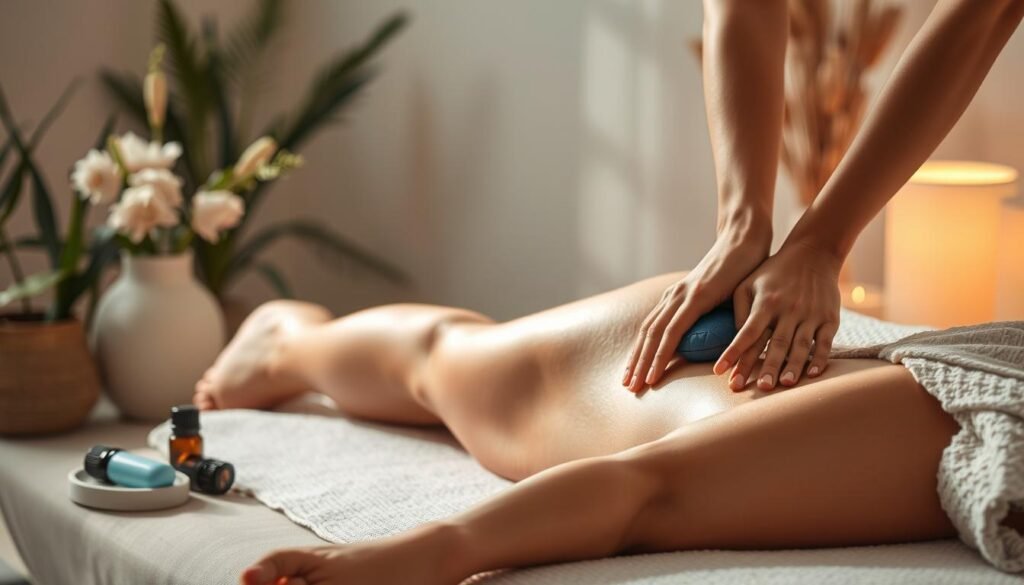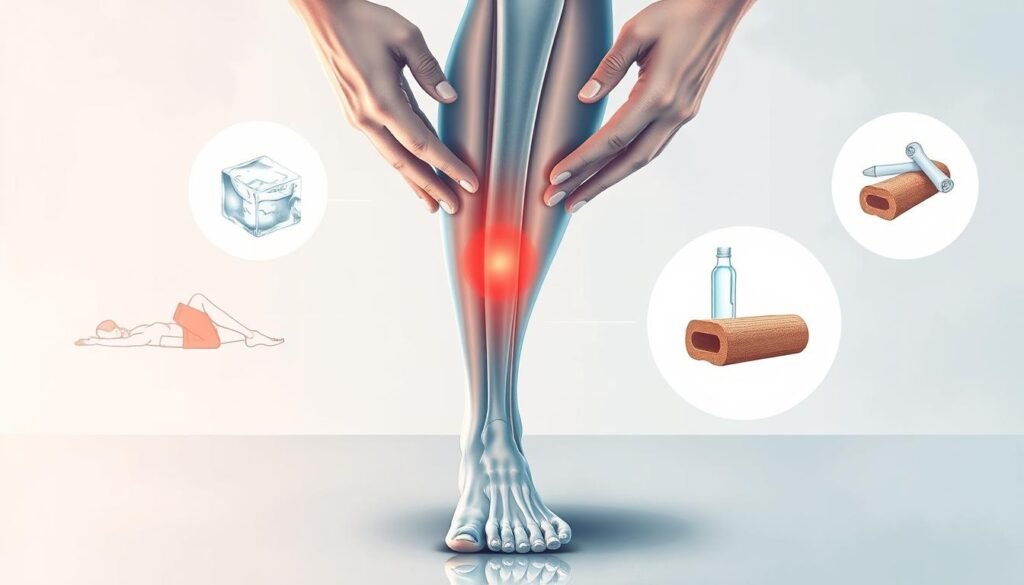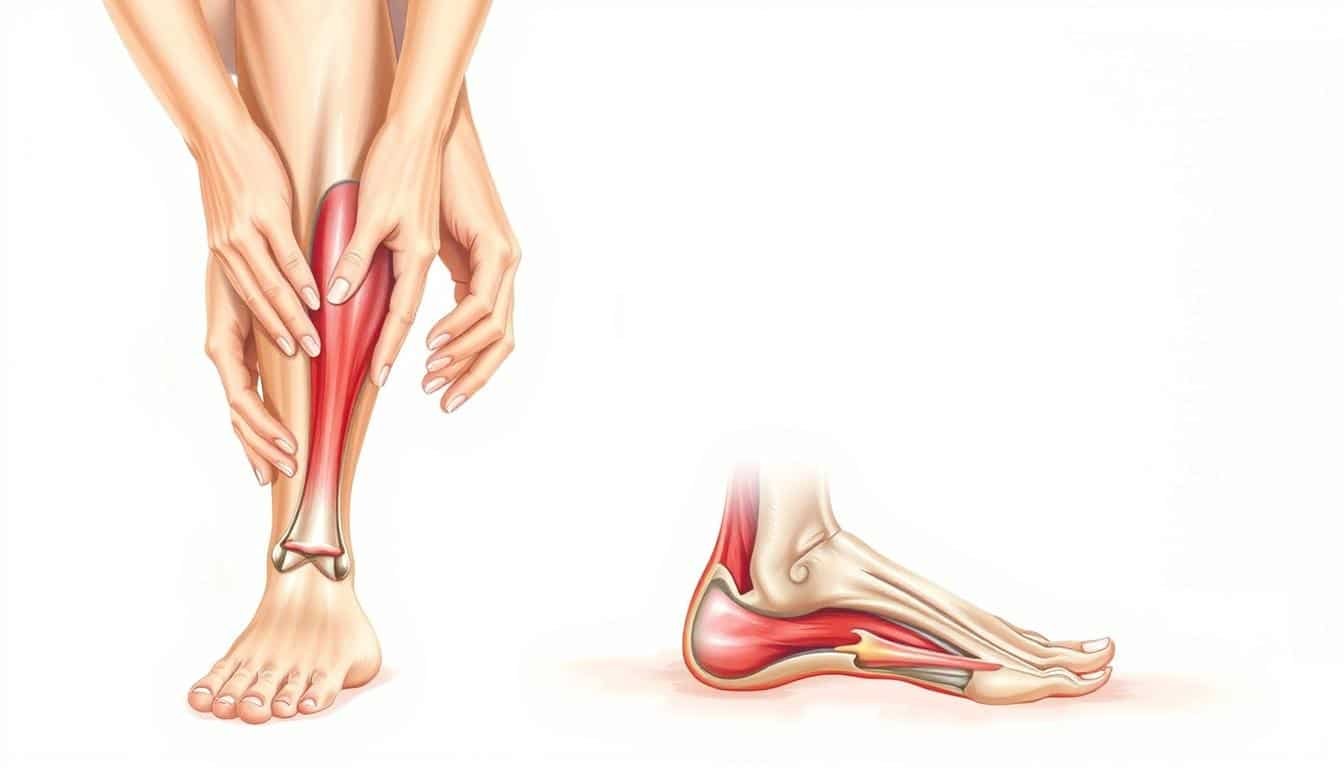Ever thought about a simple fix for shin splints at home? As someone who loves sports and staying fit, I’ve dealt with this painful issue. I’m thrilled to share a powerful solution: shin splint massage. This guide will teach you how to massage your shins effectively. It will help you ease the pain and get back to your favorite activities.
Shin splints can hurt a lot. But, the right massage can loosen tight calf muscles and ease tension. I’ll guide you on how to massage your shins safely and well. You can do it yourself at home or get help from a pro. By using these massage techniques, we can lessen pain, reduce swelling, and quicken your recovery.
Key Takeaways
- Shin splint massage can effectively reduce pain and swelling
- Targeting tight calf muscles is crucial in alleviating shin splint pain
- Both professional and self-massage techniques can be beneficial
- Massage helps release muscle knots and improves blood flow
- Regular massage can aid in preventing future shin splint occurrences
Understanding Shin Splints and Their Causes
Shin splints can be a real pain for athletes and fitness enthusiasts. Many people struggle with this common lower leg injury. Let’s explore what shin splints are, why they happen, and who’s most at risk.
What are shin splints?
Shin splints cause pain along the shinbone, or tibia. There are two main types: anterior shin splints affect the front, and medial shin splints affect the inner part. This pain usually happens when muscles and tissues around the shinbone get inflamed from too much use.
Common causes of shin splints
Several factors can lead to shin splints. Too much stress on the lower leg is a big one. This often happens when runners increase their mileage too quickly or train on hard surfaces. Tight calf muscles can also pull on the shin area, adding to the pain.
Risk factors for developing shin splints
Certain factors increase the chance of getting shin splints. These include:
- Wearing improper footwear
- Having flat feet or high arches
- Suddenly ramping up exercise intensity
- Participating in high-impact sports
Knowing these risk factors can help prevent shin splints. It can also guide how to treat them with massage. By tackling these issues early, you can lower your risk of getting this painful condition.
The Benefits of Massage for Shin Splints
Massage is key in recovering from shin splints. I’ve experienced its benefits firsthand. It can make a big difference in your treatment plan.
- Releases muscle knots
- Boosts blood flow to affected areas
- Speeds up healing process
- Prevents scar tissue buildup
- Enhances lower leg flexibility
Massage helps reduce inflammation in shin splints. It applies pressure to decrease swelling and pain. This makes it easier to move and recover.
Massage was a game-changer for my shin splints. It helped me get back to running faster than I expected.
Regular massage can also prevent future shin splint occurrences. It keeps muscles healthy and reduces tightness. This makes the lower leg more resilient.
| Benefit | Impact on Shin Splints |
|---|---|
| Increased blood flow | Accelerates healing |
| Muscle relaxation | Reduces pain and tightness |
| Scar tissue prevention | Improves long-term flexibility |
| Stress reduction | Promotes overall recovery |
Adding shin splint recovery massage to your routine can greatly improve healing. It helps you get back to your favorite activities sooner.
Different Types of Massage Techniques for Shin Splints

I’ve found that various massage techniques can effectively treat shin splints. Let’s explore some of the most effective shin splint massage methods to help alleviate pain and promote healing.
Deep Tissue Massage
Deep tissue massage targets the deeper layers of muscle and connective tissue. This technique involves applying firm pressure to release knots and tension in the shin area. It’s particularly effective for chronic shin splint pain.
Myofascial Release
Myofascial release focuses on stretching and massaging the fascia, the thin layer of tissue covering muscles. This shin splint muscle massage technique can help improve flexibility and reduce tightness in the lower leg.
Trigger Point Massage
Trigger point massage involves applying pressure to specific points in the muscle to relieve tension. For shin splints, this technique can target pain points along the tibia and surrounding muscles.
Sports Massage
Sports massage is tailored for athletes and focuses on areas prone to overuse injuries. This technique combines various methods to increase flexibility, reduce injury risk, and enhance performance.
| Massage Technique | Primary Focus | Benefits for Shin Splints |
|---|---|---|
| Deep Tissue | Deeper muscle layers | Releases chronic tension |
| Myofascial Release | Fascia and connective tissue | Improves flexibility |
| Trigger Point | Specific pain points | Targets localized pain |
| Sports Massage | Athletic performance | Enhances recovery and prevents injuries |
How to Massage Shin Splints: Step-by-Step Guide
Learning to massage shin splints can change the game for athletes and fitness lovers. I’ll show you a simple yet effective routine for self-massage. It’s easy to add to your recovery plan.
Begin by sitting on a firm surface with your legs out. Use a foam roller or massage stick under your Achilles tendon. Roll up and down your lower leg, focusing on the calf sides. Use deep pressure but stay within your comfort zone.
For a more precise massage, use a lacrosse ball for trigger points. Press the ball into tight spots where your calf meets the shin. Hold for 30 seconds, then release. Do this on both sides of your leg.
To end your massage, use light strokes on both sides of your shin. Move from your ankle to your knee with gentle pressure. This helps improve blood flow, just like a sports massage.
| Massage Technique | Duration | Pressure Level |
|---|---|---|
| Foam Rolling | 2-3 minutes per leg | Moderate to Deep |
| Trigger Point | 30 seconds per spot | Deep |
| Stroking | 1-2 minutes per leg | Light to Moderate |
Do this routine daily or after hard workouts to prevent shin splints. With regular practice, you’ll learn to massage shin splints well.
Essential Tools for Shin Splint Self-Massage

Having the right tools is key for massaging shin splints at home. I’ve found that specific self-massage tools help target the affected areas better. Let’s look at some essential tools for shin splint massage techniques.
Foam rollers
Foam rollers are great for shin splint relief. I use them to roll out the muscles around my shins. They come in different densities, so I can adjust the pressure to my liking.
Foam rolling improves blood flow and reduces muscle tension. It helps in healing the affected areas.
Massage balls
Massage balls are perfect for targeting specific trigger points. These small, dense balls are made of rubber or lacrosse. They help pinpoint tight spots.
I roll them along my shins and calves. This releases tension and promotes healing.
Massage sticks
Massage sticks provide controlled pressure and are easy to use. They’re great for massaging shin splints at home. These handheld tools let me apply precise pressure along my shins.
| Tool | Best for | Ease of Use | Portability |
|---|---|---|---|
| Foam Roller | Large muscle groups | Moderate | Low |
| Massage Ball | Trigger points | Easy | High |
| Massage Stick | Targeted pressure | Easy | Moderate |
By using these tools in my shin splint massage techniques, I’ve found relief and promoted recovery. Each tool has its own benefits, making them essential for my at-home care routine.
Combining Massage with Other Shin Splint Treatments

Treating shin splints with massage is more effective when done with other recovery methods. My strategy for shin splint recovery massage includes several steps. First, I make sure to rest the affected area to let it heal.
After massages, I use ice to reduce swelling and ease muscle pain. I also take over-the-counter pain relievers to manage discomfort. Gentle stretching exercises for my calves and shins help improve flexibility.
Slowly returning to activity and wearing the right shoes are important for my recovery. These steps help me get back on track.
Comprehensive Shin Splint Treatment Plan
| Treatment | Frequency | Benefits |
|---|---|---|
| Massage | 2-3 times per week | Improves blood flow, reduces muscle tension |
| Ice therapy | After massage or exercise | Reduces inflammation, numbs pain |
| Rest | Daily | Allows tissues to heal |
| Stretching | Daily | Increases flexibility, prevents tightness |
| Proper footwear | Always | Provides support, reduces impact |
By combining these treatments with my shin splint recovery massage, I heal faster and avoid re-injury. This comprehensive approach tackles the main causes of shin splints and boosts leg health.
Precautions and When to Avoid Massage
Shin splint massage can help with pain, but there are times to be careful. I’ll show you when to stay away from massage and when to see a doctor.
Identifying Stress Fractures
Stress fractures can feel like shin splints. Watch for pain that doesn’t get better with rest. If you think you have a stress fracture, don’t massage and see a doctor.
Recognizing Compartment Syndrome
Compartment syndrome is a serious issue in the lower leg. Look for severe pain, tight muscles, and numbness. If you see these signs, stop massage and get medical help right away.
When to Seek Medical Attention
If you’re not sure why your shin hurts or if the pain won’t go away, see a doctor first. They can tell if massage is okay for you.
| Condition | Symptoms | Action |
|---|---|---|
| Shin Splints | Dull ache along the shin | Safe for massage |
| Stress Fracture | Sharp, localized pain | Avoid massage, see doctor |
| Compartment Syndrome | Severe pain, swelling, numbness | Immediate medical attention |
Getting the right diagnosis is crucial for treatment. If your shin pain keeps coming back, talk to a doctor before trying massage.
Preventing Shin Splints with Regular Massage and Exercises
Regular shin splint self-massage has changed the game for me. It keeps my calf and shin muscles flexible and healthy. This not only prevents injuries but also boosts my leg’s performance.
Adding massage to my workout routine has been a smart move. I include calf raises and toe taps to strengthen my lower leg. These exercises help build strength and prevent shin splints.
It’s important to gradually increase exercise intensity and duration. I’ve learned that sudden changes can lead to injury. Now, I follow a plan that slowly increases my workouts, allowing my muscles to adapt.
- Proper warm-up routine
- Consistent stretching
- Wearing appropriate footwear
- Maintaining a balanced training schedule
These steps are crucial for preventing shin splints. By combining regular self-massage with these practices, I’ve greatly reduced my risk. Remember, it’s always better to prevent shin splints than to treat them!
The Role of Shin Splint Massage in Athletic Performance
Shin splint recovery massage is a game-changer for athletes. It keeps muscles flexible and cuts down the risk of shin splints. This means athletes can train more often without setbacks.
After tough workouts or races, a good shin splint muscle massage speeds up recovery time.
Quick feet are key in many sports. Massage improves lower leg function, which can boost performance in activities that need fast footwork. By adding regular massage to their routine, athletes may see gains in endurance and fewer shin splint issues.
I’ve seen how shin splint massage helps athletes stay on top of their game. It’s not just about fixing pain – it’s about preventing problems before they start. With consistent massage, athletes can push harder in training and perform better when it counts.
FAQ
What are the benefits of massage for shin splints?
What are the different types of massage techniques for shin splints?
How do I massage my shin splints at home?
What tools can I use for shin splint self-massage?
How can I combine massage with other shin splint treatments?
Are there any precautions or conditions where I should avoid massage for shin splints?
How can regular massage help prevent shin splints?
What role does shin splint massage play in athletic performance?
Source Links
- Massage Therapy for Shin Splints – https://www.vivehealth.com/blogs/resources/shin-splints-massage?srsltid=AfmBOopCPi7qOi7fW–Qqw7J7pECTl5xPUcgHAFlfIMpQsUuLnTxNu5b
- Massage for Shin Splints (Tibialis Anterior) – https://www.painscience.com/articles/spot-03-tibialis-anterior.php
- How to Do a Myofascial Release Self Massage for Shinsplints – https://www.wikihow.com/Do-a-Myofascial-Release-Self-Massage-for-Shinsplints













6 Comments
Interesting read – but do shin splint massages really work on severe cases, or is rest still the best cure?
Interesting read, but does the shin splint massage work for all age groups or does effectiveness vary? Just curious!
Effectiveness varies, no one-size-fits-all in health matters. Youth may recover faster, older folks need patience.
Interesting read! Curious, could having flat feet lead to shin splints? And would the massage technique differ?
Interesting read! Is it possible that improper running form could also contribute to shin splints, or am I mistaken?
Interesting read, but wouldnt icing before massage help reduce inflammation for shin splints more effectively? Anyone tried it?